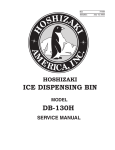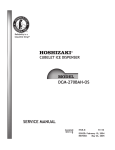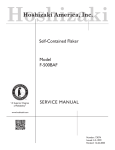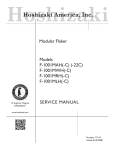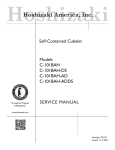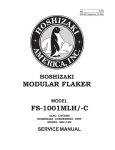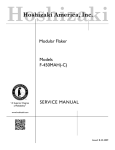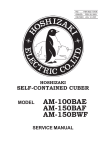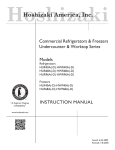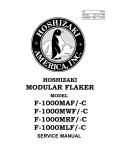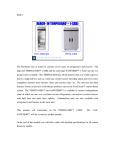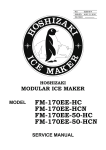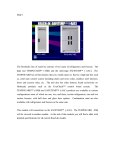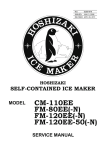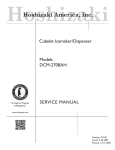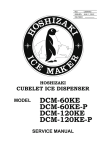Download F-801M_H/-C Service Manual
Transcript
Hoshizaki Hoshizaki America, Inc. Modular Flaker Models F-801MAH(-C) F-801MWH(-C) “A Superior Degree of Reliability” SERVICE MANUAL www.hoshizaki.com Number: 73113 Issued: 7-29-2004 Revised: 6-15-2005 IMPORTANT Only qualified service technicians should attempt to service or maintain this icemaker. No service or maintenance should be undertaken until the technician has thoroughly read this Service Manual. HOSHIZAKI provides this manual primarily to assist qualified service technicians in the service and maintenance of the icemaker. Should the reader have any questions or concerns which have not been satisfactorily addressed, please call or write to the HOSHIZAKI Technical Support Department for assistance. HOSHIZAKI AMERICA, INC. 618 Highway 74 South Peachtree City, GA 30269 Attn: HOSHIZAKI Technical Support Department Phone: 1-800-233-1940 Technical Service (770) 487-2331 Fax: 1-800-843-1056 (770) 487-3360 Web Site: www.hoshizakiamerica.com Note: To expedite assistance, all correspondence/communication MUST include the following information: • Model Number • Serial Number • Complete and detailed explanation of the problem 2 Please review this manual. It should be read carefully before the icemaker is serviced or maintenance operations are performed. Only qualified service technicians should service and maintain the icemaker. This manual should be made available to the technician prior to service or maintenance. CONTENTS I. Specification ...................................................................................................................... 5 1. Icemaker ....................................................................................................................... 5 F-801MAH .................................................................................................................. 5 F-801MWH ................................................................................................................. 6 F-801MAH-C .............................................................................................................. 7 F-801MWH-C ............................................................................................................. 8 II. General Information .......................................................................................................... 9 1. Construction ................................................................................................................. 9 F-801MAH/-C ............................................................................................................. 9 F-801MWH/-C .......................................................................................................... 10 2. Control Box Layout ..................................................................................................... 11 F-801MAH/-C ........................................................................................................... 11 F-801MWH/-C .......................................................................................................... 12 III. Technical Information ..................................................................................................... 13 1. Water Circuit and Refrigeration Circuit ........................................................................ 13 F-801MAH/-C ........................................................................................................... 13 F-801MWH/-C .......................................................................................................... 14 2. Wiring Diagrams ......................................................................................................... 15 F-801MAH/-C, F-801MWH/-C .................................................................................. 15 3. Sequence of Electrical Circuit .................................................................................... 16 4. Timing Chart ............................................................................................................... 26 5. Performance Data ....................................................................................................... 29 F-801MAH ................................................................................................................ 29 F-801MWH ............................................................................................................... 30 F-801MAH-C ............................................................................................................ 31 F-801MWH-C ........................................................................................................... 32 IV. Adjustment of Components ............................................................................................ 33 1. Adjustment of Water Regulating Valve (water-cooled model only) .............................. 33 2. Adjustment of Flake Size ............................................................................................ 34 V. Service Diagnosis........................................................................................................... 35 1. No Ice Production ....................................................................................................... 35 2. Low Ice Production ..................................................................................................... 37 3. Other ........................................................................................................................... 38 VI. Removal and Replacement of Components .................................................................. 39 1. Service for Refrigerant Lines ...................................................................................... 39 [a] Refrigerant Recovery........................................................................................... 39 [b] Evacuation and Recharge [R-404A] .................................................................... 39 2. Brazing ....................................................................................................................... 40 3. Removal and Replacement of Compressor ................................................................ 41 4. Removal and Replacement of Drier ........................................................................... 42 3 5. Removal and Replacement of Expansion Valve ......................................................... 43 6. Removal and Replacement of Water Regulating Valve (water-cooled model only) .... 44 7. Removal and Replacement of Evaporator Assembly ................................................. 45 8. Removal and Replacement of Fan Motor ................................................................... 49 9. Removal and Replacement of Control Water Valve .................................................... 49 10. Removal and Replacement of Flush Water Valve ..................................................... 50 VII. Cleaning and Maintenance .......................................................................................... 51 1. Preparing the Icemaker for Long Storage ................................................................... 51 2. Cleaning and Sanitizing Instructions .......................................................................... 52 [a] Cleaning Solution ................................................................................................ 52 [b] Cleaning Procedure ............................................................................................ 53 [c] Sanitizing Solution ............................................................................................... 54 [d] Sanitizing Procedure - Initial ................................................................................ 54 [e] Sanitizing Procedure - Final ................................................................................ 55 3. Maintenance ............................................................................................................... 57 4 I. Specification 1. Icemaker F-801MAH AC SUPPLY VOLTAGE COMPRESSOR GEAR MOTOR FAN MOTOR OTHER MAXIMUM FUSE SIZE MAX. HACR BREAKER (USA ONLY) MAX. CIRC. BREAKER (CANADA ONLY) MINIMUM CIRCUIT AMPACITY APPROXIMATE ICE PRODUCTION PER 24 HR. lbs./day ( kg/day ) Reference without *marks SHAPE OF ICE ICE QUALITY APPROXIMATE STORAGE CAPACITY ELECTRIC & WATER CONSUMPTION ELECTRIC W (kWH/100 lbs.) POTABLE WATER gal./24HR (gal./100 lbs.) EXTERIOR DIMENSIONS (WxDxH) EXTERIOR FINISH WEIGHT CONNECTIONS - ELECTRIC - WATER SUPPLY - DRAIN ICE MAKING SYSTEM HARVESTING SYSTEM ICE MAKING WATER CONTROL COOLING WATER CONTROL BIN CONTROL SYSTEM COMPRESSOR CONDENSER EVAPORATOR REFRIGERANT CONTROL REFRIGERANT CHARGE DESIGN PRESSURE PC BOARD CIRCUIT PROTECTION COMPRESSOR PROTECTION GEAR MOTOR PROTECTION REFRIGERANT CIRCUIT PROTECTION LOW WATER PROTECTION ACCESSORIES - SUPPLIED - REQUIRED OPERATING CONDITIONS 115/60/1 120 V 9.4 RLA 51 LRA 120 V 3 FLA 1/4 HP 115 V 0.85 FLA 1/15 HP 120 V 0.03 A 20 A 20 A 20 A 20 A Ambient WATER TEMP. (°F) Temp.(°F) 50 70 90 70 * 823 (373) 786 (357) 748 (339) 80 711 (323) 677 (307) 644 (292) 90 613 (278) * 599 (272) 555 (252) 100 528 (239) 502 (228) * 471 (214) Flake Approx. 70%, Ice (90/70°F, Conductivity 200 µs/cm) N/A 90/70°F 70/50°F 1131 (4.5) 1089 (3.2) 72 (12) 99 (12) 22" x 27-3/8" x 25-15/16" (560 x 695 x 658mm) Stainless Steel, Galvanized Steel (Rear) Net 176 lbs. ( 80 kg ), Shipping 207 lbs. ( 94 kg ) Permanent - Connection Inlet 1/2" FPT Outlet 3/4" FPT Auger type Direct Driven Auger ( 1/4HP Gear Motor ) Float Switch N/A Mechanical Bin Control ( Proximity Sw. ) Hermetic, Model RS43-C2E-CAA Air-cooled, Fin and Tube Type Copper Tube on Cylinder Thermostatic Expansion Valve R-404A, (800 g) 1lb 12oz High 427 PSIG, Low 230 PSIG High Voltage Cut-off Relay Auto-reset Overload Protector Fuse (3A) Auto-reset High Pressure Control Switch Float Switch and Timer Spare Fuse Ice Storage Bin VOLTAGE RANGE 104 - 127 V AMBIENT TEMP. 45 - 100° F WATER SUPPLY TEMP. 45 - 90° F WATER SUPPLY PRESSURE 10 - 113 PSIG We reserve the right to make changes in specifications and design without prior notice. 5 F-801MWH AC SUPPLY VOLTAGE COMPRESSOR GEAR MOTOR OTHER MAXIMUM FUSE SIZE MAX. HACR BREAKER (USA ONLY) MAX. CIRC. BREAKER (CANADA ONLY) MINIMUM CIRCUIT AMPACITY APPROXIMATE ICE PRODUCTION PER 24 HR. lbs./day ( kg/day ) Reference without *marks SHAPE OF ICE ICE QUALITY APPROXIMATE STORAGE CAPACITY ELECTRIC & WATER CONSUMPTION ELECTRIC W (kWH/100 lbs.) POTABLE WATER WATER-COOLED CONDENSER gal./24HR (gal./100 lbs.) EXTERIOR DIMENSIONS (WxDxH) EXTERIOR FINISH WEIGHT CONNECTIONS - ELECTRIC - WATER SUPPLY - DRAIN ICE MAKING SYSTEM HARVESTING SYSTEM ICE MAKING WATER CONTROL COOLING WATER CONTROL BIN CONTROL SYSTEM COMPRESSOR CONDENSER EVAPORATOR REFRIGERANT CONTROL REFRIGERANT CHARGE DESIGN PRESSURE PC BOARD CIRCUIT PROTECTION COMPRESSOR PROTECTION GEAR MOTOR PROTECTION REFRIGERANT CIRCUIT PROTECTION LOW WATER PROTECTION ACCESSORIES - SUPPLIED - REQUIRED OPERATING CONDITIONS 115/60/1 120 V 8.5 RLA 51 LRA 120 V 3 FLA 1/4 HP 120 V 0.03 A 20 A 20 A 20 A 20 A WATER TEMP. (°F) Ambient 50 70 90 Temp.(°F) 70 * 720 (327) 693 (315) 677 (307) 80 661 (300) 646 (293) 630 (286) 90 616 (279) * 605 (274) 587 (266) 100 573 (260) 560 (254) * 520 (236) Flake Approx. 70%, Ice (90/70°F, Conductivity 200 µs/cm) N/A 90/70°F 70/50°F 1078 (4.3) 1076 (3.6) 72 (12) 86 (12) 360 (60) 219 (31) 22" x 27-3/8" x 25-15/16" (560 x 695 x 658mm) Stainless Steel, Galvanized Steel (Rear) Net 176 lbs. ( 80 kg ), Shipping 207 lbs. ( 94 kg ) Permanent - Connection Inlet 1/2" FPT Cond. Inlet 1/2" FPT Cond. Outlet 3/8" FPT Outlet 3/4" FPT Auger type Direct Driven Auger ( 1/4HP Gear Motor ) Float Switch N/A Mechanical Bin Control ( Proximity Sw. ) Hermetic, Model RS43-C2E-CAA Water-cooled, tube in tube type Copper Tube on Cylinder Thermostatic Expansion Valve R-404A, (470 g) 1lb 1oz High 427 PSIG, Low 230 PSIG High Voltage Cut-off Relay Auto-reset Overload Protector Fuse (3A) Auto-reset High Pressure Control Switch Float Switch and Timer Spare Fuse Ice Storage Bin VOLTAGE RANGE 104 - 127 V AMBIENT TEMP. 45 - 100° F WATER SUPPLY TEMP. 45 - 90° F WATER SUPPLY PRESSURE 10 - 113 PSIG We reserve the right to make changes in specifications and design without prior notice. 6 F-801MAH-C AC SUPPLY VOLTAGE COMPRESSOR GEAR MOTOR FAN MOTOR OTHER MAXIMUM FUSE SIZE MAX. HACR BREAKER (USA ONLY) MAX. CIRC. BREAKER (CANADA ONLY) MINIMUM CIRCUIT AMPACITY APPROXIMATE ICE PRODUCTION PER 24 HR. lbs./day ( kg/day ) Reference without *marks SHAPE OF ICE ICE QUALITY APPROXIMATE STORAGE CAPACITY ELECTRIC & WATER CONSUMPTION ELECTRIC W (kWH/100 lbs.) POTABLE WATER gal./24HR (gal./100 lbs.) EXTERIOR DIMENSIONS (WxDxH) EXTERIOR FINISH WEIGHT CONNECTIONS - ELECTRIC - WATER SUPPLY - DRAIN ICE MAKING SYSTEM HARVESTING SYSTEM ICE MAKING WATER CONTROL COOLING WATER CONTROL BIN CONTROL SYSTEM COMPRESSOR CONDENSER EVAPORATOR REFRIGERANT CONTROL REFRIGERANT CHARGE DESIGN PRESSURE PC BOARD CIRCUIT PROTECTION COMPRESSOR PROTECTION GEAR MOTOR PROTECTION REFRIGERANT CIRCUIT PROTECTION LOW WATER PROTECTION ACCESSORIES - SUPPLIED - REQUIRED OPERATING CONDITIONS 115/60/1 120 V 9.4 RLA 51 LRA 120 V 3 FLA 1/4 HP 115 V 0.85 FLA 1/15 HP 120 V 0.03 A 20 A 20 A 20 A 20 A WATER TEMP. (°F) Ambient 50 70 90 Temp.(°F) 70 * 752 (341) 728 (330) 688 (312) 80 650 (295) 614 (279) 580 (263) 90 548 (249) * 552 (250) 490 (222) 100 463 (210) 437 (198) * 405 (184) Cubelet Approx. 80%, Ice (90/70°F, Conductivity 200 µs/cm) N/A 90/70°F 70/50°F 1169 (5.1) 1110 (3.5) 66 (12) 90 (12) 22" x 27-3/8" x 25-15/16" (560 x 695 x 658mm) Stainless Steel, Galvanized Steel (Rear) Net 176 lbs. ( 80 kg ), Shipping 207 lbs. ( 94 kg ) Permanent - Connection Inlet 1/2" FPT Outlet 3/4" FPT Auger type Direct Driven Auger ( 1/4HP Gear Motor ) Float Switch N/A Mechanical Bin Control ( Proximity Sw. ) Hermetic, Model RS43-C2E-CAA Air-cooled, Fin and Tube Type Copper Tube on Cylinder Thermostatic Expansion Valve R-404A, (800 g) 1lb 12oz High 427 PSIG, Low 230 PSIG High Voltage Cut-off Relay Auto-reset Overload Protector Fuse (3A) Auto-reset High Pressure Control Switch Float Switch and Timer Spare Fuse Ice Storage Bin VOLTAGE RANGE 104 - 127 V AMBIENT TEMP. 45 - 100° F WATER SUPPLY TEMP. 45 - 90° F WATER SUPPLY PRESSURE 10 - 113 PSIG We reserve the right to make changes in specifications and design without prior notice. 7 F-801MWH-C AC SUPPLY VOLTAGE COMPRESSOR GEAR MOTOR OTHER MAXIMUM FUSE SIZE MAX. HACR BREAKER (USA ONLY) MAX. CIRC. BREAKER (CANADA ONLY) MINIMUM CIRCUIT AMPACITY APPROXIMATE ICE PRODUCTION PER 24 HR. lbs./day ( kg/day ) Reference without *marks SHAPE OF ICE ICE QUALITY APPROXIMATE STORAGE CAPACITY ELECTRIC & WATER CONSUMPTION ELECTRIC W (kWH/100 lbs.) POTABLE WATER WATER-COOLED CONDENSER gal./24HR (gal./100 lbs.) EXTERIOR DIMENSIONS (WxDxH) EXTERIOR FINISH WEIGHT CONNECTIONS - ELECTRIC - WATER SUPPLY - DRAIN ICE MAKING SYSTEM HARVESTING SYSTEM ICE MAKING WATER CONTROL COOLING WATER CONTROL BIN CONTROL SYSTEM COMPRESSOR CONDENSER EVAPORATOR REFRIGERANT CONTROL REFRIGERANT CHARGE DESIGN PRESSURE PC BOARD CIRCUIT PROTECTION COMPRESSOR PROTECTION GEAR MOTOR PROTECTION REFRIGERANT CIRCUIT PROTECTION LOW WATER PROTECTION ACCESSORIES - SUPPLIED - REQUIRED OPERATING CONDITIONS 115/60/1 120 V 8.5 RLA 51 LRA 120 V 3 FLA 1/4 HP 120 V 0.03 A 20 A 20 A 20 A 20 A Ambient WATER TEMP. (°F) Temp.(°F) 50 70 90 70 * 645 (293) 620 (281) 608 (276) 80 596 (270) 585 (265) 574 (260) 90 563 (255) * 550 (249) 541 (246) 100 531 (241) 521 (236) * 485 (220) Cubelet Approx. 80%, Ice (90/70°F, Conductivity 200 µs/cm) N/A 90/70°F 70/50°F 1075 (4.7) 1083 (4.1) 66 (12) 77 (12) 302 (55) 199 (31) 22" x 27-3/8" x 25-15/16" (560 x 695 x 658mm) Stainless Steel, Galvanized Steel (Rear) Net 176 lbs. ( 80 kg ), Shipping 207 lbs. ( 94 kg ) Permanent - Connection Cond. Inlet 1/2" FPT Inlet 1/2" FPT Outlet 3/4" FPT Cond. Outlet 3/8" FPT Auger type Direct Driven Auger ( 1/4HP Gear Motor ) Float Switch N/A Mechanical Bin Control ( Proximity Sw. ) Hermetic, Model RS43-C2E-CAA Water-cooled, tube in tube type Copper Tube on Cylinder Thermostatic Expansion Valve R-404A, (470 g) 1lb 1oz High 427 PSIG, Low 230 PSIG High Voltage Cut-off Relay Auto-reset Overload Protector Fuse (3A) Auto-reset High Pressure Control Switch Float Switch and Timer Spare Fuse Ice Storage Bin VOLTAGE RANGE 104 - 127 V AMBIENT TEMP. 45 - 100° F WATER SUPPLY TEMP. 45 - 90° F WATER SUPPLY PRESSURE 10 - 113 PSIG We reserve the right to make changes in specifications and design without prior notice. 8 II. General Information 1. Construction F-801MAH/-C Control Water Valve Water Supply Inlet Bin Control Junction Box Ice Chute Condenser Evaporator Fan Motor Expansion Valve Compressor Flush Water Valve Drier Control Box Gear Motor 9 F-801MWH/-C Control Water Valve Water Supply Inlet Bin Control Junction Box Ice Chute Evaporator Water Regulator Expansion Valve Compressor Flush Water Valve Drier Control Box Gear Motor 10 2. Control Box Layout F-801MAH/-C FLUSH TIMER WATER CONTROL RELAY TRANSFORMER GEAR MOTOR RELAY CONNECTOR FLUSH CIRCUIT PROTECT RELAY FAN MOTOR CAP PRESSURE SWITCH GEAR MOTOR PROTECT RELAY GEAR MOTOR CAP. FLUSH SWITCH ICE POWER SWITCH STARTER FUSE START CAPACITOR FUSE (GEAR MOTOR) RUN CAPACITOR CONTROL TIMER Note: The above component names are identical with the wiring label, but not with the parts list. 11 F-801MWH/-C FLUSH TIMER WATER CONTROL RELAY TRANSFORMER GEAR MOTOR RELAY CONNECTOR CIRCUIT PROTECT RELAY PRESSURE SWITCH FLUSH GEAR MOTOR CAP. FLUSH SWITCH ICE POWER SWITCH GEAR MOTOR PROTECT RELAY STARTER FUSE START CAPACITOR RUN CAPACITOR CONTROL TIMER 12 FUSE (GEAR MOTOR) III. Technical Information 1. Water Circuit and Refrigeration Circuit F-801MAH/-C 13 F-801MWH/-C 14 2. Wiring Diagrams F-801MAH/-C, F-801MWH/-C 15 3. Sequence of Electrical Circuit [a] When power switch is moved to “ON” position and flush switch to “ICE” position, water starts to be supplied to reservoir. 16 [b] When reservoir has been filled, gear motor starts immediately. 17 [c] Compressor starts about 60 sec. after gear motor starts. 18 [d] Bin control operates, and about 6 sec. later, compressor and gear motor stop simultaneously. 19 [e] Low water (except water-cooled model). 20 [f] Low water (water-cooled model), or dirty air filter (air-cooled model), pressure switch to “OPEN”, compressor and gear motor operate intermittently. 21 [g] When flush switch is moved to “FLUSH” position, flush water valve opens and flushes reservoir and evaporator. 22 [h] When flush timer operates (for 15 min. every 12 hours). 23 [i] When 208-230V are supplied to circuit protect relay, it protects the circuit from miswiring. If the power supply is properly connected, the contact of circuit protect relay does not move even when the coil is energized. 24 [j] When input voltage is too low, (less than 70%), gear motor fuse (1.5A) is blown causing the compressor and gear motor to turn off immediately. 25 4. Timing Chart Miswiring. Circuit Protect Relay operates.) Proper wiring. The unit starts. BIN CONTROL OFF 1. CIRCUIT PROTECT RELAY ON ON OFF UPPER 2. WATER LEVEL UPPER 3. FLOAT SWITCH LOWER 4. WATER CONTROL RELAY 5. CONTROL WATER VALVE 6. FLUSH TIMER 7. FLUSH SWITCH 8. FLUSH WATER VALVE 9. BIN CONTROL LOWER BOTTOM ON OFF ON OFF ON OFF ON OFF 1-2 2-3 FLUSH ICE ON OFF ON OFF 1 sec 10. GEAR MOTOR RELAY 11. GEAR MOTOR 12. FAN MOTOR 6 sec OFF ON OFF ON OFF 60 sec 13. COMPRESSOR 1 sec ON 60 sec ON OFF 14. PRESSURE ON SWITCH OFF 26 FLUSH TIMER LOW WATER 1. CIRCUIT PROTECT RELAY ON OFF UPPER 2. WATER LEVEL UPPER 3. FLOAT SWITCH LOWER 4. WATER CONTROL RELAY 5. CONTROL WATER VALVE 6. FLUSH TIMER LOWER BOTTOM ON OFF ON OFF ON OFF ON OFF 1-2 2-3 21 min every 12 hr FLUSH 7. FLUSH SWITCH 8. FLUSH WATER VALVE 9. BIN CONTROL ICE ON OFF ON OFF 150 sec 10. GEAR MOTOR RELAY 11. GEAR MOTOR 12. FAN MOTOR 1 sec 1 sec OFF ON OFF ON OFF 90 sec 13. COMPRESSOR 150 sec ON 60 sec ON OFF 14. PRESSURE ON SWITCH OFF 27 90 sec 60 sec FLUSH SWITCH FLUSH 1. CIRCUIT PROTECT RELAY PRESSURE SWITCH ICE OFF ON ON OFF UPPER 2. WATER LEVEL UPPER 3. FLOAT SWITCH LOWER 4. WATER CONTROL RELAY 5. CONTROL WATER VALVE 6. FLUSH TIMER LOWER BOTTOM ON OFF ON OFF ON OFF ON OFF 1-2 2-3 FLUSH 7. FLUSH SWITCH 8. FLUSH WATER VALVE 9. BIN CONTROL ICE ON OFF ON OFF 150 sec 10. GEAR MOTOR RELAY 11. GEAR MOTOR 12. FAN MOTOR 1 sec OFF ON OFF ON OFF 90 sec 13. COMPRESSOR 1 sec ON 60 sec 60 sec ON OFF 14. PRESSURE ON SWITCH OFF 1 sec 28 5. Performance Data F-801MAH APPROXIMATE ICE PRODUCTION PER 24 HR. lbs./day ( kg/day) APPROXIMATE ELECTRIC CONSUMPTION watts APPROXIMATE WATER CONSUMPTION PER 24 HR. (TOTAL) gal. / day (l/day) EVAPORATOR OUTLET TEMP. °F (°C) HEAD PRESSURE PSIG (kg/cm2G) SUCTION PRESSURE PSIG (kg/cm2G) TOTAL HEAT OF REJECTION Ambient Temp. (F) 70 80 90 100 70 80 90 100 70 80 90 100 70 80 90 100 70 80 90 100 70 80 90 100 Water Temp. (F) 50 70 90 * 823 (373) 786 (357) 748 (339) 711 (323) 677 (307) 644 (292) 613 (278) * 599 (272) 555 (252) 528 (239) 502 (228) * 471 (214) * 1089 -1095 -1101 -1107 -1113 -1119 -1125 -* 1131 -1147 -1164 -1181 -* 1197 -* 99 (374) 94 (357) 90 (340) 85 (323) 81 (308) 77 (293) 74 (278) * 72 (272) 67 (252) 63 (240) 60 (228) * 57 (214) * 15 (-10) 16 (-9) 16 (-9) 16 (-9) 16 (-9) 17 (-8) 17 (-8) * 17 (-8) 18 (-8) 19 (-7) 19 (-7) * 20 (-7) * 204 (14.3) 266 (18.7) 302 (21.2) 204 (14.3) 266 (18.7) 302 (21.2) 204 (14.3) * 266 (18.7) 302 (21.2) 204 (14.3) 266 (18.7) * 302 (21.2) * 38 (2.7) 42 (3.0) 46 (3.3) 38 (2.7) 42 (3.0) 46 (3.3) 38 (2.7) * 42 (3.0) 46 (3.3) 38 (2.7) 42 (3.0) * 46 (3.3) 6398 BTU/h (AT 90°F / WT 70°F) Note: The data without *marks should be used for reference. We reserve the right to make changes in specifications and design without prior notice. 29 F-801MWH APPROXIMATE ICE PRODUCTION PER 24 HR. lbs./day ( kg/day) APPROXIMATE ELECTRIC CONSUMPTION watts APPROXIMATE WATER CONSUMPTION PER 24 HR. (TOTAL) gal. / day (l/day) EVAPORATOR OUTLET TEMP. °F (°C) HEAD PRESSURE PSIG (kg/cm2G) SUCTION PRESSURE PSIG (kg/cm2G) Ambient Temp. (F) 70 80 90 100 70 80 90 100 70 80 90 100 70 80 90 100 70 80 90 100 70 80 90 100 WATER FLOW FOR CONDENSER PRESSURE DROP OF COOLING WATER LINE HEAT OF REJECTION FROM CONDENSER HEAT OF REJECTION FROM COMPRESSOR Water Temp. (F) 50 70 90 * 720 (327) 693 (315) 677 (307) 661 (300) 646 (293) 630 (286) 616 (279) * 605 (274) 587 (266) 573 (260) 560 (254) * 520 (236) * 1076 -1076 -1076 -1076 -1077 -1077 -1077 -* 1078 -1076 -1074 -1071 -* 1069 -* 306 (1158) 397 (1504) 631 (2387) 318 (1205) 415 (1571) 666 (2520) 331 (1251) * 433 (1638) 704 (2666) 344 (1304) 457 (1728) * 778 (2944) * 17 (-8) 17 (-8) 18 (-8) 19 (-7) 19 (-7) 20 (-7) 20 (-7) * 20 (-7) 20 (-7) 20 (-7) 20 (-7) * 21 (-6) * 265 (18.6) 265 (18.6) 266 (18.7) 265 (18.6) 265 (18.6) 266 (18.7) 265 (18.6) * 265 (18.6) 266 (18.7) 265 (18.6) 265 (18.6) * 266 (18.7) * 42 (3.0) 43 (3.0) 44 (3.1) 42 (3.0) 43 (3.0) 44 (3.1) 42 (3.0) * 43 (3.0) 44 (3.1) 42 (3.0) 43 (3.0) * 44 (3.1) 15 gal/h (AT 90°F / WT 70°F) Less than 7 PSIG 5155 BTU/h (AT 90°F / WT 70°F) 1050 BTU/h (AT 90°F / WT 70°F) Note: The data without *marks should be used for reference. We reserve the right to make changes in specifications and design without prior notice. 30 F-801MAH-C APPROXIMATE ICE PRODUCTION PER 24 HR. lbs./day (kg/day) APPROXIMATE ELECTRIC CONSUMPTION watts APPROXIMATE WATER CONSUMPTION PER 24 HR. (TOTAL) gal. / day (l/day) EVAPORATOR OUTLET TEMP. °F (°C) HEAD PRESSURE PSIG (kg/cm2G) SUCTION PRESSURE PSIG (kg/cm2G) TOTAL HEAT OF REJECTION Ambient Temp. (F) 70 80 90 100 70 80 90 100 70 80 90 100 70 80 90 100 70 80 90 100 70 80 90 100 Water Temp. (F) 50 70 90 * 752 (341) 728 (330) 688 (312) 650 (295) 614 (279) 580 (263) 548 (249) * 552 (250) 490 (222) 463 (210) 437 (198) * 405 (184) * 1110 -1112 -1124 -1136 -1148 -1160 -1172 -* 1169 -1196 -1209 -1222 -* 1251 -* 90 (342) 87 (331) 83 (313) 78 (295) 74 (279) 70 (264) 66 (249) * 66 (251) 59 (222) 56 (210) 52 (199) * 49 (184) * 14 (-10) 14 (-10) 14 (-10) 14 (-10) 14 (-10) 14 (-10) 14 (-10) * 14 (-10) 16 (-9) 16 (-9) 18 (-8) * 18 (-8) * 200 (14.0) 212 (14.9) 219 (15.4) 226 (15.9) 233 (16.4) 241 (16.9) 249 (17.5) * 265 (18.6) 265 (18.6) 273 (19.2) 282 (19.8) * 296 (20.8) * 38 (2.7) 41 (2.9) 42 (2.9) 42 (2.9) 42 (3.0) 42 (3.0) 43 (3.0) * 43 (3.0) 43 (3.0) 43 (3.1) 44 (3.1) * 48 (3.3) 6398 BTU/h (AT 90°F / WT 70°F) Note: The data without *marks should be used for reference. We reserve the right to make changes in specifications and design without prior notice. 31 F-801MWH-C APPROXIMATE ICE PRODUCTION PER 24 HR. lbs./day ( kg/day) APPROXIMATE ELECTRIC CONSUMPTION watts APPROXIMATE WATER CONSUMPTION PER 24 HR. (TOTAL) gal. / day (l/day) EVAPORATOR OUTLET TEMP. °F (°C) HEAD PRESSURE PSIG (kg/cm2G) SUCTION PRESSURE PSIG (kg/cm2G) Ambient Temp. (F) 70 80 90 100 70 80 90 100 70 80 90 100 70 80 90 100 70 80 90 100 70 80 90 100 WATER FLOW FOR CONDENSER PRESSURE DROP OF COOLING WATER LINE HEAT OF REJECTION FROM CONDENSER HEAT OF REJECTION FROM COMPRESSOR Water Temp. (F) 50 70 90 * 645 (293) 620 (281) 608 (276) 596 (270) 585 (265) 574 (260) 563 (255) * 550 (249) 541 (246) 531 (241) 521 (236) * 485 (220) * 1083 -1082 -1081 -1080 -1078 -1077 -1076 -* 1075 -1073 -1072 -1070 -* 1068 -* 276 (1046) 342 (1294) 579 (2192) 287 (1086) 354 (1339) 605 (2291) 296 (1119) * 368 (1392) 633 (2397) 305 (1156) 381 (1442) * 693 (2622) * 20 (-7) 20 (-7) 21 (-6) 21 (-6) 21 (-6) 21 (-6) 21 (-6) * 21 (-6) 21 (-6) 21 (-6) 21 (-6) * 22 (-6) * 263 (18.5) 263 (18.5) 264 (18.6) 263 (18.5) 263 (18.5) 264 (18.6) 263 (18.5) * 263 (18.5) 264 (18.6) 263 (18.5) 263 (18.5) * 264 (18.6) * 46 (3.2) 46 (3.3) 47 (3.3) 46 (3.2) 46 (3.3) 47 (3.3) 46 (3.2) * 46 (3.3) 47 (3.3) 46 (3.2) 46 (3.3) * 47 (3.3) 13 gal/h (AT 90°F / WT 70°F) Less than 7 PSIG 5155 BTU/h (AT 90°F / WT 70°F) 1050 BTU/h (AT 90°F / WT 70°F) Note: The data without *marks should be used for reference. We reserve the right to make changes in specifications and design without prior notice. 32 IV. Adjustment of Components 1. Adjustment of Water Regulating Valve (water-cooled model only) The water regulating valve or also called “water regulator” is factory-adjusted. No adjustment is required under normal use. Adjust the water regulator , if necessary, using the following procedures. 1) Attach a pressure gauge to the high-side line of the system. Or prepare a thermometer to check the condenser drain temperature. 2) Rotate the adjustment screw by using a flat blade screwdriver, so that the pressure gauge shows 260 PSIG (R-404A models/-F type), or the thermometer reads 100 -104°F, in 5 minutes after the icemaking process starts. When the pressure exceeds 260 PSIG, or the condenser drain temperature exceeds 104°F, rotate the adjustment screw counterclockwise. 3) Check that the pressure or the condenser drain temperature holds a stable setting. Adjustment Screw Adjustment Screw CW CCW Bottom View CW - Higher CCW - Lower 33 2. Adjustment of Flake Size To adjust the flake size, change the direction of the cutter head on the top of the auger, according to the following procedures: 1) Remove the bolt and the cutter head. FINE 2) The cutter head has two holes, one for fine flake and the other for coarse flake size. The unit is shipped from the factory in the fine flake position. COARSE 3) Place the cutter head so that the pin on the top of the auger fits into the selected hole. 4) Secure the cutter head by the bolt. 34 V. Service Diagnosis 1. No Ice Production PROBLEM [1] [2] The icemaker will not start. Water flow does not stop, and the icemaker will not start POSSIBLE CAUSE a) Power Supply OFF position. Loose connection. Bad contacts. 1. 2. 3. b) Power Switch (Control Box) 4. 1. 2. c) Fuse (Control Box) 1. Blown out. 1. d) Circuit Protect Relay 1. Miswiring. 1. e) Flush Timer 1. 2. Flushing out. Bad contacts. 1. 2. f) Flush Switch 1. 2. FLUSH position. Bad contacts. 1. 2. g) h) i) Transformer Control Water Valve Shut-off Valve 1. 1. 1. 2. Coil winding opened. Coil winding opened. Closed. Water failure. 1. 1. 1. 2. j) Plug and Receptacle (Control Box) 1. 2. 1. 2. a) Water Control Relay b) Float Switch 1. 2. 1. Disconnected. Terminal out of Plug or Receptacle. Contact fused. Coil winding opened. Bad contacts. 2. Move to ON position. Tighten. Check for contintinuity and replace. Replace. Move to ON position. Check for continuity and replace. Check for short circuit and replace. Check power supply voltage and wire properly. Wait for 15 minutes. Check for continuity and replace. Move to ICE position. Check for continuity and replace. Replace. Replace. Open. Wait till water is supplied. Connect. Insert Terminal back in position Replace. Replace. Check for continuity and replace. Clean or replace. Blown fuse. Off position. Bad contacts. 4. 1. 2. 1. Clean or replace 1. 1. Connect. Check for continuity and replace. Check for continuity and replace. Clean Axle and its corresponding holes or replace Bin Control. Replace. 2. [3] Water has been supplied, but the icemaker will not start. REMEDY 1. 2. 3. 1. 2. 1. c) Flush Water Valve 1. d) a) Hoses Water Control Relay 1. 1. Float does not move freely. Valve seat clogged and water leaking. Disconnected. Bad contacts. b) Bin Control 1. Bad contacts. 1. 2. Activator does not move freely. 2. 1. Coil winding opened. 1. 2. bad contacts. 2. Check for continuity and replace. c) Gear Motor Relay d) Control Timer (Printed Circuit Board) 1. Broken. 1. Replace. e) Gear Motor Protect Relay 1. Coil winding opened. 1. Replace. 2. Bad contacts. 2. Check for continuity and replace. 35 PROBLEM [4] Water has been supplied, Fan Motor starts, but Gear Motor and Compressor will not start. [5] Gear Motor and Compressor start but operate intermittently. POSSIBLE CAUSE 1. Blown Fuse. 1. See "3. [3]." Find out the cause and replace the Fuse. b) Thermal Protector (Gear Motor) 1. Bad contacts. 1. Check for continuity and replace. a) Pressure Switch 1. Dirty Air Filter or Condenser. Ambient or condenser water temperature too warm. Condenser water pressure too low or off. (Water-cooled model only) Water Regulating Valve set too high. (Water-cooled model only) Fan not rotating. 1. Clean. 2. Get cooler. 3. Check and get recommended pressure. 4. Adjust it lower. 5. 6. 8. Refrigerant overcharged. Refrigerant line or components plugged. Bad contacts. See "3. [1] a) Fan Motor." Recharge. 9. 1. Loose connections. Bad contacts. 9. 1. b) Starter 2. 1. Coil winding opened. Bad contacts. 2. 1. c) 2. 3. 1. Coil winding opened. Loose Connections. Defective. 1. 2. 3. 4. 5. 6. 7. [6] Gear Motor starts, but Compressor will not start or operates intermittently. 7. Clean and replace drier. 8. 2. 3. 1. Check for continuity and replace. Tighten. Replace.Check for continuity and replace. Replace Timer. Check for continuity and replace. Replace. Tighten. Replace. Loose connections. 1. Tighten. 2. Motor winding opened or grounded. 2. Replace. 3. Motor Protector tripped. 3. e) Power Supply 1. 1. a) Refrigerant Line 1. Circuit Ampacity too low. Gas leaks. refrigerant line clogged. 2. Find out the cause of overheat or overcurrent. Install a larger-sized conductor. Check for leaks with a leak detector. Reweld leak, replace drier and charge with refrigerant. The amount of refrigerant is marked on Nameplate or Label. Replace the clogged component. a) X2 Relay on Control Timer Start Capacitor or Run Capacitor d) Compressor [7] Gear Motor and Compressor start, but no ice is produced. REMEDY a) Gear Motor Fuse (BUSSMAN GMD 1.5A) 2. 36 1. 2. Low Ice Production PROBLEM [1] Low ice production POSSIBLE CAUSE a) Refrigerant Line 1. Gas leaks. 2. Refrigerant line clogged. 3. Overcharged. b) High-side Pressure Too High c) Expansion Valve (not adjustable) 1. Dirty Air Filter or Condenser. 2. Ambient or condenser water temperature too warm. 3. Condenser water pressure too low or off. [Water-cooled model only] 4. Fan rotating too slow. 5. Water Regulating Valve clogged. [Water-cooled model only] 6. Condensing unit out of order. 1. Low-side pressure too low. 2. Low-side pressure too high. 37 REMEDY 1. See "1. [5] a) Refrigerant Line." 2. Replace the clogged component. 3. Recharge. 1. Clean. 2. Get cooler. 3. Check and get recommended pressure. 4. See "3 [1] a) Fan Motor." 5. Clean. 6. Check condensing unit. 1. Replace. 2. See if Expansion Valve Bulb is mounted properly, and replace the valve if necessary. 3. Other PROBLEM [1] Abnormal noise POSSIBLE CAUSE a) Fan Motor b) Compressor c) Refrigerant Lines d) Gear Motor (Ice Making) e) Evaporator [2] Overflow from Reservoir (Water does not stop.) a) Water Supply b) Control Water Valve c) Float Switch [3] Gear Motor Fuse blown frequently. 1. Bearing worn out. 2. Fan blade deformed. 3. Fan blade does not move freely. 1. Bearings worn out, or cylinder valve broken. 2. Mounting pad out of position. 1. Rub or touch lines or other surfaces. 1. Bearing or Gear worn out / damaged. 1. Too much pressure loss. 2. Scale on inside wall of Freezing Cylinder. 1. Water pressure too high. 1. Diaphragm does not close. 1. Bad contacts. a) Power Supply Voltage 1. Too high or too low. b) Ice Making Unit 1. Bearings or Auger worn out. 1. Bad contacts. c) Bin Control 2. Activator does not move freely. 38 REMEDY 1. Replace. 2. Replace fan blade. 3. Replace. 1. Replace. 2. Reinstall. 1. Replace. 1. Replace. 1. Replace. 2. Remove Auger. Use "SCALE AWAY" or "LIME-A-WAY" solution to clean periodically. If the water is found hard by testing, install a softener. 1. Install a pressure Reducing Valve 1. Clean or replace. 1. Check for continuity and replace. 1. Connect the unit to a power supply of proper voltage. 1. Replace Bearing or Auger. 1. Check for continuity and replace. 2. Clean Axle and its corresponding holes or replace Bin Control. VI. Removal and Replacement of Components IMPORTANT Ensure all components, fasteners and thumbscrews are securely in place after the equipment is serviced. IMPORTANT 1. The Polyolester (POE) oils used in R-404A units can absorb moisture quickly. Therefore it is important to prevent moisture from entering the system when replacing or servicing parts. 2. Always install a new filter drier every time the sealed refrigeration system is opened. 3. Do not leave the system open for longer than 15 minutes when replacing or servicing parts. 1. Service for Refrigerant Lines [a] Refrigerant Recovery The icemaker unit is provided with two refrigerant access valves - one on the low-side and one on the high-side line. Using proper refrigerant practices recover the refrigerant from the access valves and store it in an approved container. Do not discharge the refrigerant into the atmosphere. [b] Evacuation and Recharge [R-404A] 1) Attach charging hoses, a service manifold and a vacuum pump to the system. Be sure to connect charging hoses to both high-side and low-side access valves. IMPORTANT The vacuum level and vacuum pump may be the same as those for current refrigerants. However, the rubber hose and gauge manifold to be used for evacuation and refrigerant charge should be exclusively for POE oils. 2) Turn on the vacuum pump. Never allow the oil in the vacuum pump to flow backward. 3) Allow the vacuum pump to pull down to a 29.9" Hg vacuum. Evacuating period depends on pump capacity. 39 4) Close the low-side valve and high-side valve on the service manifold. 5) Disconnect the vacuum pump, and attach a refrigerant service cylinder to the highside line. Remember to loosen the connection, and purge the air from the hose. See the nameplate for the required refrigerant charge. Hoshizaki recommends only virgin refrigerant or reclaimed refrigerant which meets ARI Standard No. 700-88 be used. 6) A liquid charge is recommended for charging an R-404A system. Invert the service cylinder. Open the high-side, service manifold valve. 7) Allow the system to charge with liquid until the pressures balance. 8) If necessary, add any remaining charge to the system through the low-side. Use a throttling valve or liquid dispensing device to add the remaining liquid charge through the low-side access port with the unit running. 9) Close the two refrigerant access valves, and disconnect the hoses and service manifold. 10) Cap the access valves to prevent a possible leak. 2. Brazing DANGER 1. Refrigerant R-404A itself is not flammable at atmospheric pressure and temperatures up to 176° F. 2. Refrigerant R-404A itself is not explosive or poisonous. However, when exposed to high temperatures (open flames) R-404A can be decomposed to form hydrofluoric acid and carbonyl fluoride both of which are hazardous. 3. Always recover the refrigerant and store it in an approved container. Do not discharge the refrigerant into the atmosphere. 4. Do not use silver alloy or copper alloy containing arsenic. 5. Do not use R-404A as a mixture with pressurized air for leak testing. Refrigerant leaks can be detected by charging the unit with a little refrigerant, raising the pressure with nitrogen and using an electronic leak detector. 40 3. Removal and Replacement of Compressor IMPORTANT Always install a new drier every time the sealed refrigeration system is opened. Do not replace the drier until after all other repairs or replacement have been made. 1) Turn off the power supply, and remove the panels. 2) Remove the terminal cover on the compressor, and disconnect the compressor wiring. 3) Recover the refrigerant and store it in an approved container, if required by an applicable law. 4) Remove the discharge, suction and access pipes from the compressor using brazing equipment. WARNING When repairing a refrigerant system, be careful not to let the burner flame contact any electrical wires or insulation. 5) Remove the bolts and rubber grommets. 6) Slide and remove the compressor. Unpack the new compressor package. Install the new compressor. 7) Attach the rubber grommets of the prior compressor. 8) Sandpaper the discharge, suction and access pipes. 9) Place the compressor in position, and secure it using the bolts. 10) Remove plugs from the discharge, suction and access pipes. 11) Braze the access, suction and discharge lines (Do not change this order), while purging with nitrogen gas flowing at the pressure of 3 - 4 PSIG. 12) Install the new drier. 13) Check for leaks using nitrogen gas (140 PSIG) and soap bubbles. 41 14) Evacuate the system, and charge it with refrigerant. For the air-cooled and water-cooled models, see the nameplate for the required refrigerant charge and type. For the remote aircooled models, see the label on the control box. 15) Connect the terminals to the compressor, and replace the terminal cover in its correct position. 16) Replace the panels in their correct position, and turn on the power supply. 4. Removal and Replacement of Drier IMPORTANT Always install a new drier every time the sealed refrigeration system is opened. Do not replace the drier until after all other repairs or replacement have been made. 1) Turn off the power supply, and remove the panels. 2) Recover the refrigerant and store it in an approved container, if required by an applicable law. 3) Remove the drier using brazing equipment. 4) Install the new drier with the arrow on the drier in the direction of the refrigerant flow. Use nitrogen gas at the pressure of 3 - 4 PSIG when brazing the tubings. 5) Check for leaks using nitrogen gas (140 PSIG) and soap bubbles. 6) Evacuate the system, and charge it with refrigerant. For the air-cooled and water-cooled models, see the nameplate for the required refrigerant charge and type. For the remote air-cooled models, see the label on the control box. 7) Replace the panels in their correct position, and turn on the power supply. 42 5. Removal and Replacement of Expansion Valve IMPORTANT Sometimes moisture in the refrigerant circuit exceeds the drier capacity and freezes up at the expansion valve. Always install a new drier every time the sealed refrigeration system is opened. Do not replace the drier until after all other repairs or replacement have been made. 1) Turn off the power supply, and remove the panels. 2) Recover the refrigerant and store it in an approved container, if required by an applicable law. 3) Remove the expansion valve bulb at the evaporator outlet. 4) Remove the expansion valve cover, and remove the expansion valve using brazing equipment. 5) Braze the new expansion valve with nitrogen gas flowing at the pressure of 3 - 4 PSIG. WARNING Always protect the valve body by using a damp cloth to prevent the valve from overheating. Do not braze with the valve body exceeding 250°F. 6) Install the new drier. 7) Check for leaks using nitrogen gas (140 PSIG) and soap bubbles. 8) Evacuate the system. Charge it with refrigerant. For the air-cooled and water-cooled models, see the nameplate for the required refrigerant charge and type. For the remote air-cooled models, see the label on the control box. 9) Attach the bulb to the suction line. Be sure to secure the bulb using a band and to insulate it. 10) Place the new set of expansion valve covers in position. 11) Replace the panels in their correct position, and turn on the power supply. 43 6. Removal and Replacement of Water Regulating Valve (water-cooled model only) IMPORTANT Always install a new drier every time the sealed refrigeration system is opened. Do not replace the drier until after all other repairs or replacement have been made. 1) Turn off the power supply, remove the panels and close the water supply line shut-off valve. 2) Recover the refrigerant and store it in an approved container. 3) Disconnect the capillary tube using brazing equipment. 4) Disconnect the flare-connections of the valve. 5) Remove the screws and the valve from the bracket. 6) Install the new valve, and braze the capillary tube. 7) Install the new drier. 8) Check for leaks using nitrogen gas (140 PSIG) and soap bubbles. 9) Connect the flare-connections. 10) Evacuate the system, and charge it with refrigerant. See the nameplate for the required refrigerant charge and type. 11) Open the water supply line shut-off valve, and turn on the power supply. 12) Check for water leaks. 13) See “IV. 1. Adjustment of Water Regulating Valve.” If necessary, adjust the valve. 14) Replace the panels in their correct position. 44 7. Removal and Replacement of Evaporator Assembly 1) Turn off the power supply. 2) Remove the panels. 3) Move the flush switch to the "FLUSH" position. 4) Turn on the power supply and drain out all water from the water line. 5) Turn off the power supply. 6) Remove the strap connecting the spout to the chute assembly. 7) Remove the three thumbscrews and take off the spout from the evaporator. Cutter 8) Remove the bolt and lift off the cutter. 9) Remove the rubber O-ring and the nylon ring at the top of the evaporator. Extruding Head 10) Remove the four socket head cap screws and lift off the extruding head. 11) Replace the bearing inside the extruding head, if it exceeds the wear tolerance of 0.02" or is scratched. Note: Replacing the bearing requires a bearing press adaptor. If it is not available, replace the whole extruding head. Auger 12) Lift off the auger. If the area in contact with the bearing is worn out or the blade scratched, replace the auger. Evaporator Note: Skip the following steps 13) through 15) when the evaporator does not need replacement. 45 13) Recover the refrigerant and store it in an approved container, if required by an applicable law. IMPORTANT Always install a new drier every time the sealed refrigeration system is opened. Do not replace the drier until after all other repairs or replacement have been made. 14) Remove the bulb of the expansion valve. 15) Disconnect the brazing-connections of the expansion valve and the copper tube -low side from the evaporator, using brazing equipment. 16) Remove the two truss head machine screws and the strap securing the evaporator. 17) Disconnect the three hoses from the evaporator. 18) Remove the four socket head cap screws securing the evaporator with the bearinglower. 19) Lift off the evaporator. Bearing-Lower and Mechanical Seal 20) The mechanical seal consists of two parts. One moves along with the auger, and the other is fixed on the bearing-lower. If the contact surfaces of these two parts are worn or scratched, the mechanical seal may cause water leaks and should be replaced. 21) Remove the O-ring on the bearing-lower. 22) Remove the four bolts and the bearing-lower from the gear motor. Replace the bearing inside the bearing-lower, if it exceeds the wear tolerance of 0.02" or is scratched. Note: Replacing the bearing requires a bearing press adaptor. If it is not available, replace the whole bearing-lower. Gear Motor 23) Remove the coupling-spline on the gear motor shaft. 24) Remove the barrier on the top of the gear motor. 25) Remove the three socket head cap screws securing the gear motor. 46 26) Assemble the removed parts in the reverse order of the above procedure. WARNING Be careful not to scratch the surface of the O-ring, or it may cause water leaks. Handle the mechanical seal with care not to scratch nor to contaminate its contact surface. 27) When replacing the evaporator; (a) Braze the new evaporator with nitrogen gas flowing at the pressure of 3 - 4 PSIG. (b) Replace the drier. (c) Check for leaks using nitrogen gas (140 PSIG) and soap bubbles. (d) Evacuate the system. Charge it with refrigerant. For the air-cooled and water-cooled models, see the nameplate for required refrigerant charge and type. For the remote air-cooled models, see the label on the control box. 28) Move the flush switch to the "ICE" position. 29) Replace the panels in their correct position. 30) Turn on the power supply. 47 Rubber O-ring Nylon Ring Bolt Washer Auger Cutter Extruding Head Washer Mechanical Seal Socket Head Cap Screw O-ring Bearing - Lower Evaporator Washer Bolt Socket Head Cap Screw Washer Coupling - Spline Barrier Gear Motor 48 8. Removal and Replacement of Fan Motor 1) Turn off the power supply and remove the panels. 2) Remove the wire connectors from the fan motor leads. 3) Remove the fan motor bracket and fan motor. 4) Install the new fan motor. 5) Replace the fan motor bracket and the wire connectors. 6) Replace the panels in their correct position, and turn on the power supply. 9. Removal and Replacement of Control Water Valve 1) Turn off the power supply, remove the panels and close the water supply line shut-off valve. 2) Disconnect the terminals from the control water valve. 3) Loosen the fitting nut on the control water valve inlets, and remove the control water valve. Do not lose the packings inside the fitting nut. 4) Remove the water supply hose from the control water valve. 5) Install the new control water valve. 6) Assemble the removed parts in the reverse order of the above procedure. 7) Open the water supply line shut-off valve. 8) Check for water leaks. 9) Replace the panels in their correct position, and turn on the power supply. 49 10. Removal and Replacement of Flush Water Valve 1) Turn off the power supply, remove the panels and close the water supply line shut-off valve. 2) Remove the clamp and disconnect the hose from the flush water valve. Note: Water may still remain inside the evaporator. Be sure to drain the water into the drain pan. 3) Disconnect the terminals from the flush water valve. 4) Remove the flush water valve from the bracket. 5) Remove the drain pipe from the flush water valve. 6) Connect the drain pipe to the new flush water valve, and place the valve in position. 7) Connect the hose to the flush water valve and secure it with the clamp. 8) Pour water into the reservoir, and check for water leaks on the flush water valve. 9) Open the water supply line shut-off valve, and turn on the power supply. 10) Move the flush switch to the "ICE" position. 11) Check for water leaks. 12) Move the flush switch to the "FLUSH" position, and make sure water is flushing. 13) Move the flush switch to the "ICE" position. 14) Replace the panels in their correct position. 50 VII. Cleaning and Maintenance IMPORTANT Ensure all components, fasteners and thumbscrews are securely in place after any maintenance or cleaning is done to the equipment. 1. Preparing the Icemaker for Long Storage WARNING When shutting off the icemaker for an extended time, drain out all water from the water line and remove the ice from the storage bin. The storage bin should be cleaned and dried. Drain the icemaker to prevent damage to the water supply line at sub-freezing temperatures, using air or carbon dioxide. Shut off the icemaker until the proper ambient temperature is resumed. [Air-Cooled and Remote Air-Cooled Models] 1) Run the icemaker with the water supply line shut-off valve closed. 2) Open the drain valve and blow out the water inlet line by using air pressure. 3) Turn off the power supply. 4) Remove the front panel. Shut-off Valve 5) Move the flush switch on the control box to the “FLUSH” position. 6) Turn on the power supply, and then drain out all water from the water line. Drain Valve 7) Turn off the power supply. 8) Turn off the power switch on the control box. 9) Replace the front panel in its correct position. 10) Close the drain valve. 11) Remove all ice from the storage bin, and clean the bin. 51 Air or CO2 [Water-Cooled Models] 1) Turn off the power supply and wait for 3 minutes. 2) Turn on the power supply and wait for 20 seconds. 3) Close the water supply line shut-off valve. 4) Open the drain valve and quickly blow the water supply line from the drain valve to drain water in the condenser. 5) Follow the above steps 3) through 11) in [Air-Cooled and Remote Air-Cooled Models]. 2. Cleaning and Sanitizing Instructions WARNING 1. HOSHIZAKI recommends cleaning this unit at least once a year. More frequent cleaning, however, may be required in some existing water conditions. 2. To prevent injury to individuals and damage to the icemaker, do not use ammonia type cleaners. 3. Always wear liquid-proof gloves to prevent the cleaning and sanitizing solutions from coming into contact with skin. [a] Cleaning Solution Dilute 4.8 fl. oz. (142 ml) of recommended cleaner Hoshizaki “Scale Away” or “LIME-A-WAY” (Economics Laboratory, Inc.) with 0.8 gallons (3 l) of warm water. This is a minimum amount. Make more solution if necessary. IMPORTANT For safety and maximum effectiveness, use the solution immediately after dilution. 52 [b] Cleaning Procedure The cleaning process will remove lime deposits from the water system. 1) Remove the front panel and top panel, then turn off the power supply. 2) Close the water supply line shut-off valve. 3) Remove all ice from the storage bin. 4) Move the flush switch to the “FLUSH” position. 5) Turn on the power supply and drain out all water from the water line. 6) Turn off the power supply. 7) Remove the strap connecting the spout to the chute assembly. 8) Remove the thumbscrews securing the spout and lift it off. 9) Pour the cleaning solution over the extruding head until the evaporator assembly and the reservoir are filled and the solution starts to overflow into the drain pan. Note: If there is excess scale on the extruding head, fill the evaporator assembly and reservoir as described above, then use a clamp on the reservoir hose between the reservoir and evaporator assembly to block flow. Pour additional cleaning fluid over the extruding head until the evaporator assembly is completely full. 10) Replace the spout and strap in their correct positions. 11) Allow the icemaker to sit for about 10 minutes before operation. If you placed a clamp on the reservoir hose in step 9, remove it before operation. 12) Move the flush switch to the “ICE” position, then turn on the power supply. Replace the top panel and front panel in their correct positions. Make ice using the solution until the icemaker stops making ice. 13) Remove the front panel. 14) Move the flush switch to the “FLUSH” position to drain the remainder of the solution. 15) After the solution is drained, move the flush switch to the “ICE” position. 16) Replace the front panel in its correct position. 17) Open the water supply line shut-off valve and supply water to the reservoir. 18) When the gear motor starts, remove the front panel and turn off the power supply. 19) Drain out all water from the water line. See 4) through 6). 53 [c] Sanitizing Solution Dilute 2.5 fl. oz. (74 ml or 5 tbs) of IMS-II Sanitizer or a 5.25% sodium hypochlorite solution (chlorine bleach) with 5 gallons (19 l) of warm water. IMPORTANT For safety and maximum effectiveness, use the solution immediately after dilution. [d] Sanitizing Procedure - Initial The sanitizing process will sanitize the icemaker. 1) Close the water supply line shut-off valve. 2) Remove the strap connecting the spout to the chute assembly. 3) Remove the thumbscrews securing the spout and lift it off. Remove the rubber O-ring and nylon O-ring at the top of the cylinder and also remove the packing between the spout and the chute. 4) Pour the sanitizing solution over the extruding head until the evaporator assembly and the reservoir are filled and the solution starts to overflow into the drain pan. 5) Remove the two thumbscrews securing the proximity switch to the chute assembly. 6) Remove the chute assembly from the icemaker. 7) Remove the packing at the bottom of the ice chute. 8) Remove the three ties and the chute insulation. 9) Remove the six wing nuts and two baffles. 10) Remove the two thumbscrews, the plate and the packing from the top of the ice chute, then remove the bin control assembly by sliding it slightly toward the chute opening and lifting it off. 11) Disassemble the bin control assembly by removing the two snap pins, shaft and actuator. 12) Soak the removed parts in .25 gallons (1 l) of sanitizing solution for 10 minutes then wipe them down. 13) Rinse the parts thoroughly. IMPORTANT If the solution is left on these parts, they will rust. 54 14) Replace all parts in their correct positions. IMPORTANT When installing the baffles, make sure that the bent surface (the one without the studs) faces the actuator so that the bent surface can guide the ice to the center of the actuator. 15) Move the flush switch to the “ICE” position, then turn on the power supply. Replace the top panel and front panel in their correct positions. Make ice using the solution until the icemaker stops making ice. [e] Sanitizing Procedure - Final 1) Remove the front panel and top panel, then turn off the power supply. 2) Move the flush switch to the “FLUSH” position. 3) Turn on the power supply and drain out all water from the water line. 4) Turn off the power supply. 5) Remove the strap connecting the spout to the chute assembly. 6) Remove the thumbscrews securing the spout and lift it off. 7) Pour the sanitizing solution over the extruding head until the evaporator assembly and the reservoir are filled and the solution starts to overflow into the drain pan. 8) Replace the spout and strap in their correct positions. 9) Allow the icemaker to sit for about 10 minutes before operation. 10) Move the flush switch to the “ICE” position, then turn on the power supply. Replace the top panel and front panel in their correct positions. Make ice using the solution until the icemaker stops making ice. 11) Remove the front panel. 12) Move the flush switch to the “FLUSH” position to drain the remainder of the solution. 13) After the solution is drained, move the flush switch to the “ICE” position. 14) Replace the front panel in its correct position. 15) Open the water supply line shut-off valve and supply water to the reservoir. 55 16) When the gear motor starts, remove the front panel and turn off the power supply. 17) Drain out all water from the water line. See 2) and 3). 18) Move the flush switch to the “ICE” position and run the icemaker. 19) Turn off the power supply after 30 minutes. 20) Pour warm water into the storage bin to melt all ice, and then clean the bin liner with the solution. 21) Flush out any solution from the storage bin. 22) Turn on the power supply and start the automatic icemaking process. IMPORTANT 1. After cleaning, do not use ice made from the sanitizing solution. Be careful not to leave any solution in the storage bin. 2. Follow carefully any instructions provided with the bottles of cleaning or sanitizing solution. 3. Never run the icemaker when the reservoir is empty. 56 3. Maintenance IMPORTANT 1. This icemaker must be maintained individually, referring to the instruction manual and labels provided with the icemaker. 2. To have the optimum performance of this icemaker, the following consumable parts need periodical inspection, maintenance and replacement: Extruding Head Housing Gear Motor Auger Mechanical Seal These parts should be inspected at least once a year or every 10,000 hours of operation. Their service life, however, depends on water quality and environment. More frequent inspection and maintenance are recommended. Consult with your local distributor about inspection and maintenance service. To obtain the name and phone number of your local distributor, call Hoshizaki Technical Support at 1-800-233-1940. 1) Stainless Steel Exterior To prevent corrosion, wipe the exterior occasionally with a clean and soft cloth. Use a damp cloth containing a neutral cleaner to wipe off oil or dirt build up. 2) Storage Bin and Scoop * Wash your hands before removing ice. Use the plastic scoop provided (bin accessory). * The storage bin is for ice use only. Do not store anything else in the bin. * Keep the scoop clean. Clean using a neutral cleaner and rinse thoroughly. * Clean the bin liner using a neutral cleaner. Rinse thoroughly after cleaning. 57 3) Air Filter (air-cooled model only) A plastic mesh air filter removes dirt or dust from the air, and keeps the condenser from getting clogged. As the filter gets clogged, the icemaker’s performance will be reduced. Check the filter at least twice a month. When clogged, use warm water and a neutral cleaner to wash the filter. 4) Condenser (except water-cooled model) Check the condenser once a year, and clean if required by using a brush or vacuum cleaner. More frequent cleaning may be required depending on the location of the icemaker. 58


























































